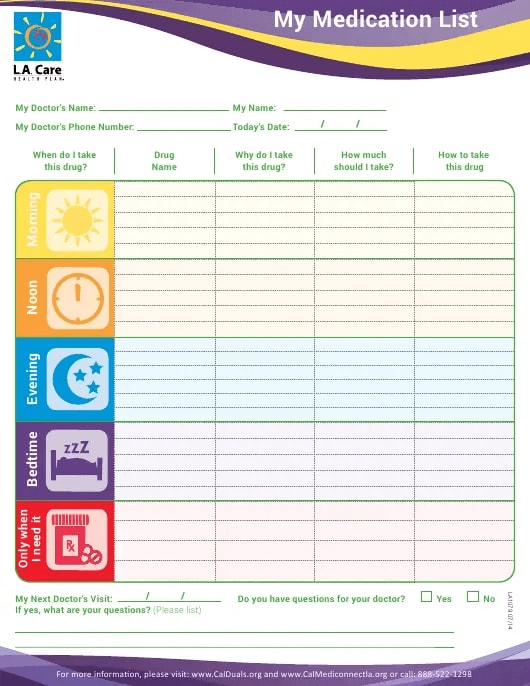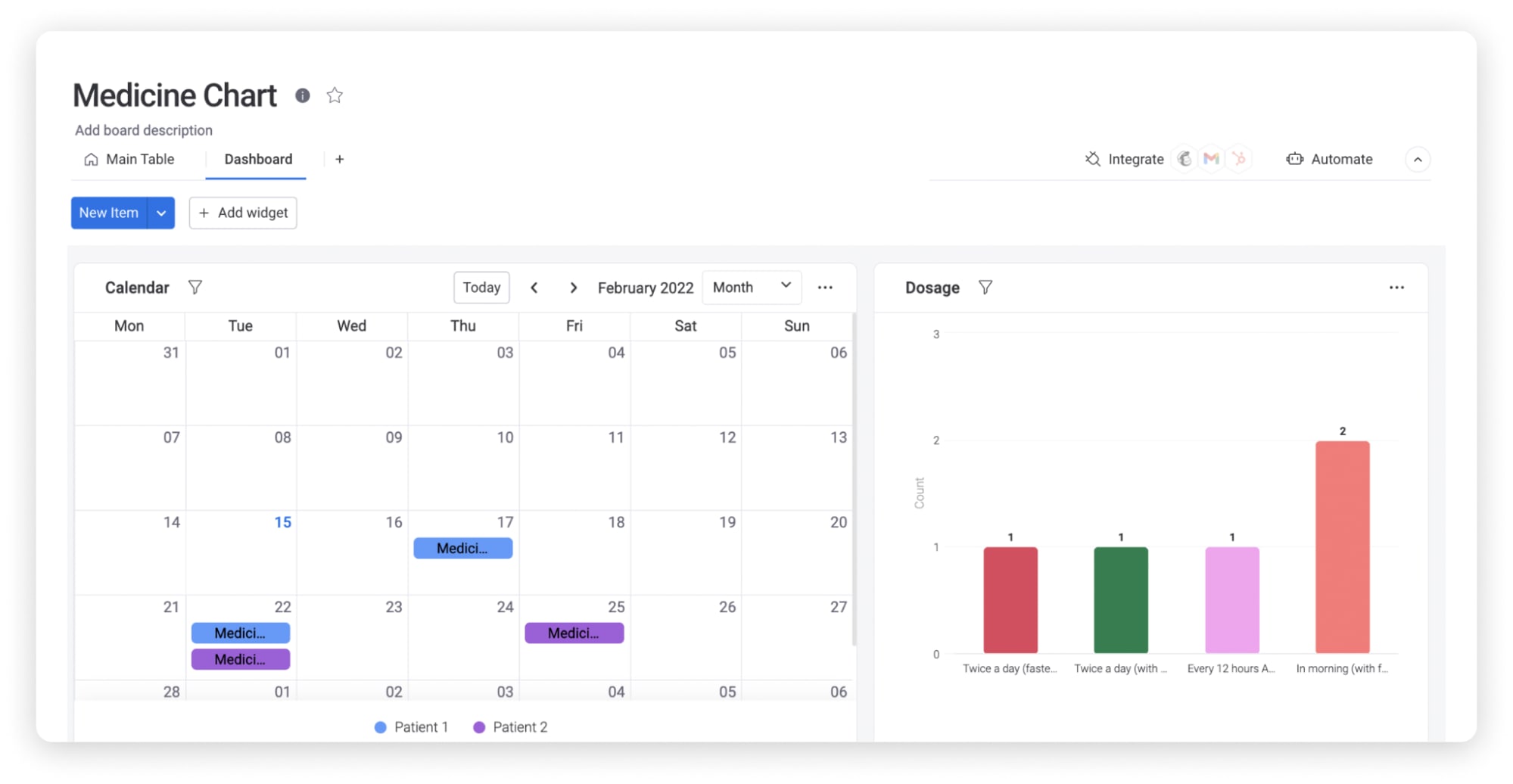As a healthcare provider, whether you’re experimenting with a new medication or increasing a patient’s dosage, keeping a record of the medication taken — and any side effects they experience — is an important process for looking after your patient’s health and safety. A medicine chart template makes it easy to record important treatment information.
In this article, we’ll review what a medicine chart template is, how they track medication consumption, and go over how healthcare providers can use them to determine the best long-term prescriptions. We’ll even share a free template from the monday.com Work OS and show you how it can transform how you track medication consumption.
What is a medicine chart template?
A medication chart template is a customizable document that can help you set up an individual medical chart more efficiently, or manage multiple patients from one view.

They’re typically structured as a table, with fields for each type of medication, the required dosage, and specific notes such as:
- Whether your patients need to take the medication with food or not
- The time of day they need to take the medication
- Reason for taking the medication, such as their medical history
But enough about what a medicine chart template is, let’s talk about what it can do for you and your practice.
Why use a medicine chart template?
Templates speed up the process of creating a medicine chart, as you’re not starting from a blank document every time you need to start a new one!
For nurses and caretakers, medication schedule templates are even more beneficial, as they ensure a level of consistency across different charts and multiple patients, but there are other benefits as well.
Templates mean fewer human errors
A standardized template reduces the likelihood of human error — as all professionals within the organization use the same chart, they understand how to use and interpret them — and helps to organize the patient’s medical information more neatly. When it comes time for them to attend doctor’s appointments, the doctor should have no issue reviewing a stack of weekly medicine charts as they all have identical formatting.
They help you set your patients up for success
Professionally structured medicine charts help you by:
- making sure your patient is taking your medication regularly and keeping up with the correct dosages
- tracking how they respond to new medication and noting any side effects they experience
Health professionals who use a weekly medication chart set their patients up for success, and a template makes the process painless for both patients and doctors.
To help demonstrate these benefits, let’s explore a few different types of medicine chart templates.
A few examples of medicine chart templates
From simple charts to intuitive solutions, there’s a lot out there.
Simple medicine chart template
This template is a great example of how simple yet effective a medicine chart can be. You don’t need to maintain a huge, complex spreadsheet to track your medicine intake accurately, all you need is a template with these columns:
- The patient’s medication
- Required medication dosages
- The date the patient started taking the medication
- Any noticeable changes
This medicine chart template is particularly useful for anyone starting a new medication who wishes to document any changes — positive or otherwise — that occur once they begin their course of treatment.

Detailed medicine chart template
This medicine chart template is a little more complex, and is intended for use by medical professionals. It includes more crucial medication details such as when the medication needs to be taken, what the medication is for, and whether it needs to be taken with or without food. You’ll also notice columns for important information such as the doctor who started the treatment course, important dates — such as when dosages are changed — and side effects to track potential reactions or even medication allergies.

Medicine chart template with instructions
Medicine charts can sometimes feel a little, well, medical. But these helpful templates don’t need to be filled with jargon; they can just as easily include simple instructions written in layman’s terms.
This template, for example, uses easy-to-understand questions — “Why do I take this drug?”, “How much should I take?” — rather than stuffy terms like medication frequency or requirements. It also includes a really helpful section at the bottom where patients can jot down any questions they might wish to ask their doctor at their next visit.

monday.com’s intuitive medicine chart template
We’ve covered a few examples of medicine chart templates to give you a bit of inspiration to create your own. But you’ll notice one thing: they’re all static sheets that you’ll need to print out and fill in by hand. That’s why we built you a digital medicine chart template on the monday.com Work OS.
Leave your paper and pens where they are, and forget about forgetting where you left your medication chart — it’s time to go digital.
Here are just a few reasons we think you’ll love using this medicine chart template on monday.com:
- Sharing – monday.com makes it easy to share boards and collaborate with other users, so you can easily forward your medicine chart to your patients or even other doctors!
- Reporting – If you’re managing medication for multiple patients, you can easily pull data together to report on aspects such as total medication usage. You can also compare doses and usage over time.

- Mobile – Download the monday.com mobile app, and you’ll have access to all your medicine charts wherever you go, as long as you’ve got your phone with you — and yes, our mobile app is HIPAA compliant.
- Single point of access – For health professionals managing medicine charts for multiple patients, you’ll enjoy the added benefit of having all the charts in a single place, so you can update in bulk after a medication run.
If it’s your first time using a medicine chart template, we’ve got you covered with a ways to ease the transition
Medicine chart template tips & tricks
Set reminders to take your medicine
A medicine chart template is helpful, but only if your patients remember to actually take their medication! If they’re tracking their meds using an old-school solution — like a Microsoft Excel spreadsheet — they’ll have to set an alarm manually. If, however, you’ve downloaded the medicine chart template on monday.com, you can create a custom automated reminder to notify your patients in the mobile app when it’s time to take their daily medication!
Note down side effects as you experience them
Nearly all medications have potential side effects, and everyone reacts differently to various meds. Use your medicine chart template to note any side effects you experience — or encourage your patients to do so — so you can discuss solutions with them the next time the prescription is up for review.
Set aside time to reflect on the effects of the medication you’re taking
Life gets pretty busy, and we often don’t sit down to really think about whether the medication is doing what it’s supposed to or just how well it’s working. Consider making a point of sitting down monthly — or weekly, if you’re on a new medication — to analyze the effects of the medication you’re on. Your medicine chart should be able to help with this, as you can create a column to track anything you notice throughout the month.
FAQs about medicine chart templates
How do you make a medicine chart?
A medicine chart should include the following columns:
- The name of the medication you are taking
- The dosage you need to take
- Time of day you need to take the medication
- Any notes or side effects you experience
- Whether the medication needs to be taken with food or not
How do you keep track of prescription drugs?
The best way to keep track of prescription drugs is to use a medicine chart template. These helpful documents tell you exactly what meds you need to take and when, and provide an opportunity to write down any thoughts you want to note down, such as the side effects you’re experiencing.
How can you ensure you do not run out of medicine?
There are two strategies to employ to ensure you don’t run out of prescription medication. You should implement both.
- Use a medicine chart to track the medication you need to take on a regular basis, ensuring you keep up with the required dosage.
- As soon as you fill a prescription, set a reminder appointment in your calendar to notify you when your prescription is nearly finished, so you can contact your health professional to refill it early.

